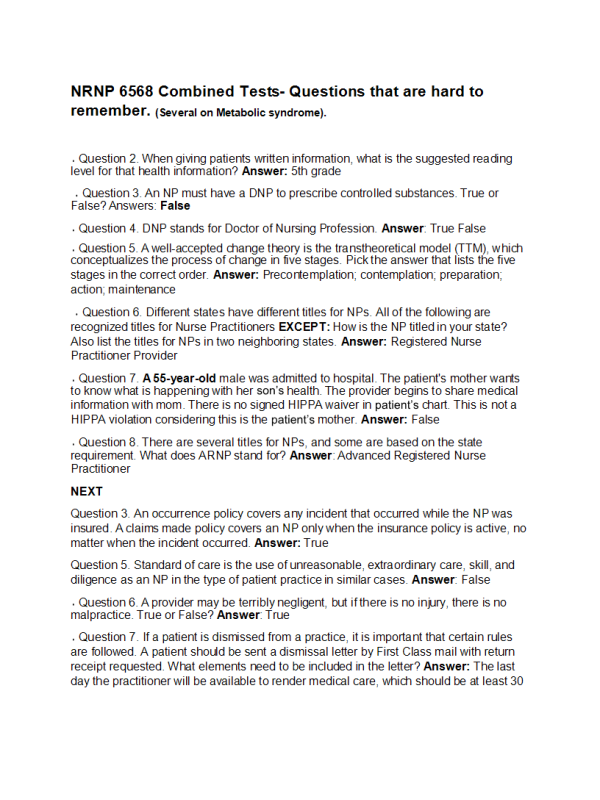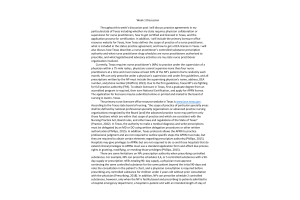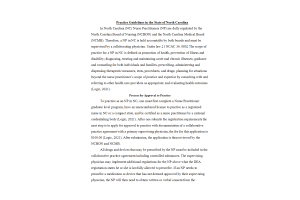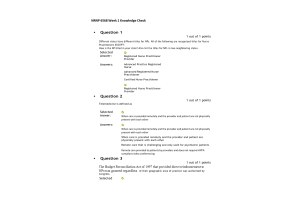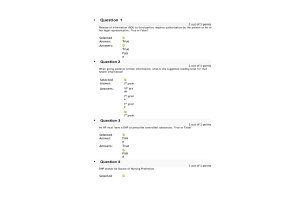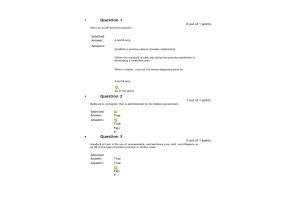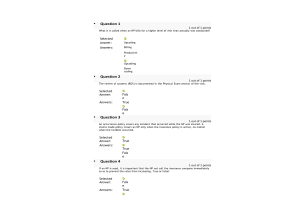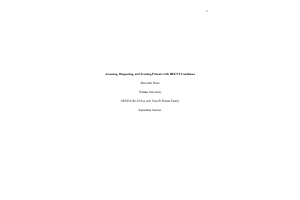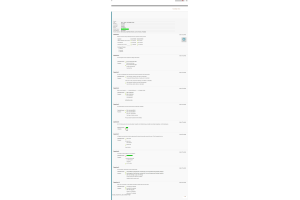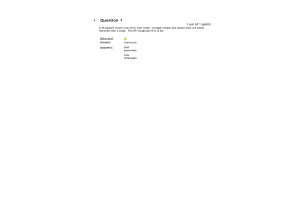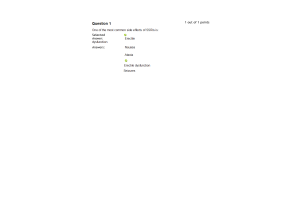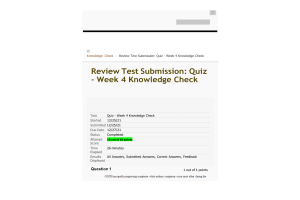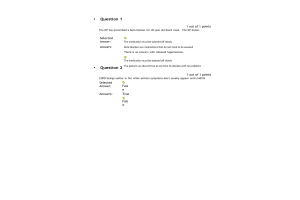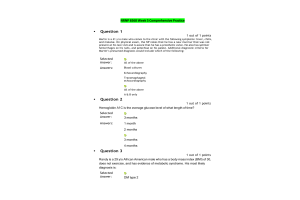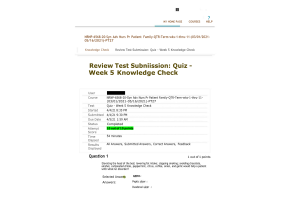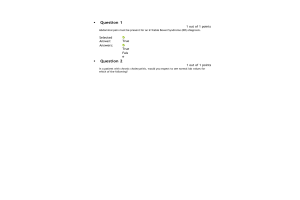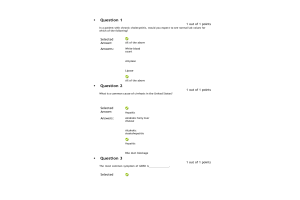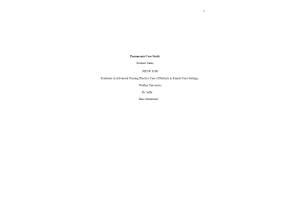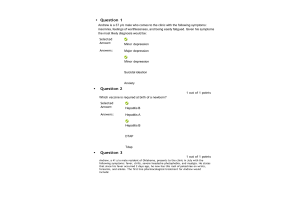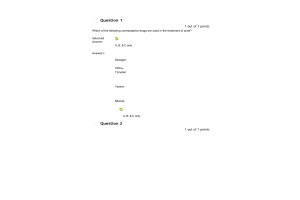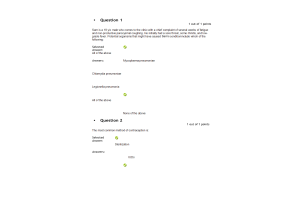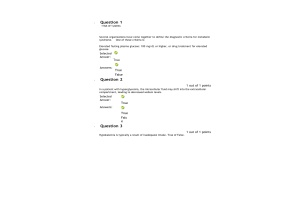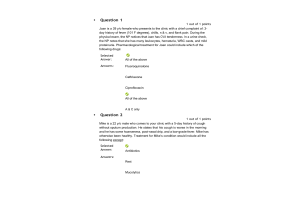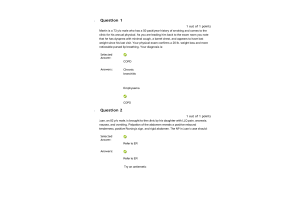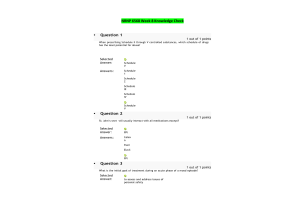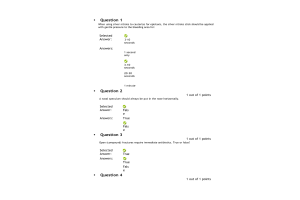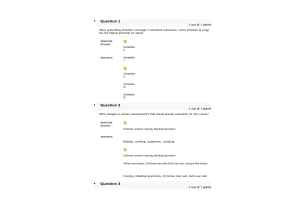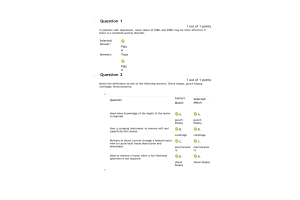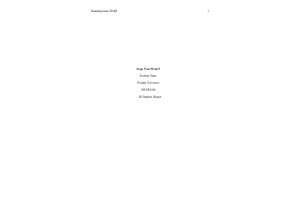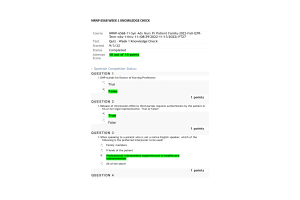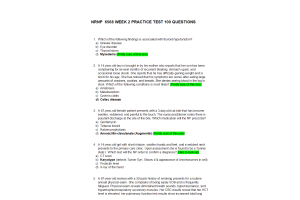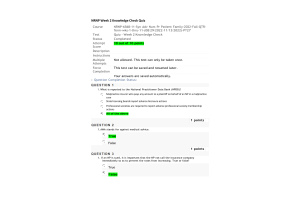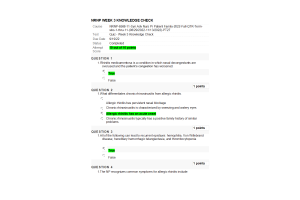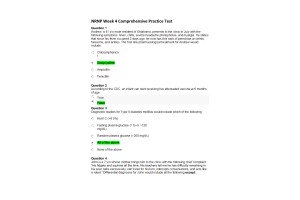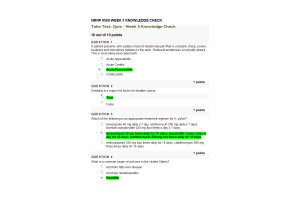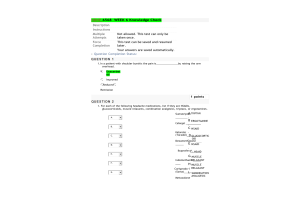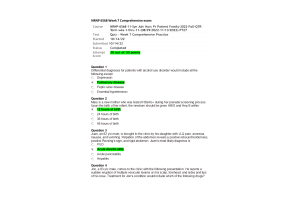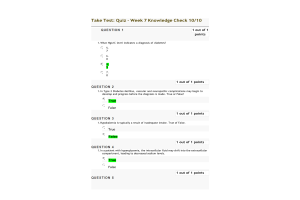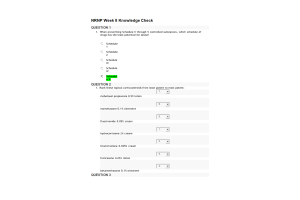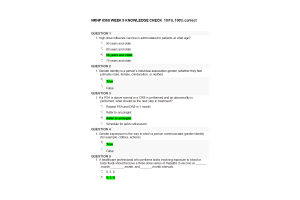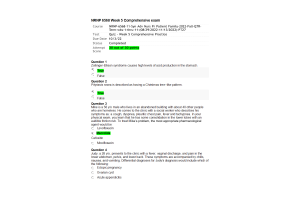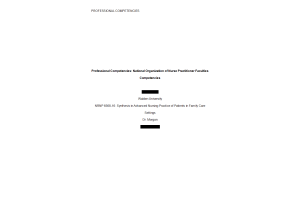xNRNP 6568 Combined Tests- Questions that are hard to remember
- $59.00
- Question: When giving patients written information, what is the suggested reading level for that health information?
- Question: An NP must have a DNP to prescribe controlled substances. True or False?
- Question: DNP stands for Doctor of Nursing Profession.
- Question: A well-accepted change theory is the transtheoretical model (TTM), which conceptualizes the process of change in five stages. Pick the answer that lists the five stages in the correct order.
- Question: Different states have different titles for NPs. All of the following are recognized titles for Nurse Practitioners EXCEPT: How is the NP titled in your state?
- Question: A 55-year-old male was admitted to hospital. The patient's mother wants to know what is happening with her son’s health. The provider begins to share medical information with mom. There is no signed HIPPA waiver in patient’s chart. This is not a HIPPA violation considering this is the patient’s mother.
- Question: There are several titles for NPs, and some are based on the state requirement. What does ARNP stand for?
Next
- Question: An occurrence policy covers any incident that occurred while the NP was insured. A claims made policy covers an NP only when the insurance policy is active, no matter when the incident occurred.
- Question: Standard of care is the use of unreasonable, extraordinary care, skill, and diligence as an NP in the type of patient practice in similar cases.
- Question: A provider may be terribly negligent, but if there is no injury, there is no malpractice. True or False?
- Question: If a patient is dismissed from a practice, it is important that certain rules are followed. A patient should be sent a dismissal letter by First Class mail with return receipt requested. What elements need to be included in the letter?
.
Next
- Question: An occurrence policy covers any incident that occurred while the NP was insured. A claims made policy covers an NP only when the insurance policy is active, no matter when the incident occurred
- Question: Standard of care is the use of unreasonable, extraordinary care, skill, and diligence as an NP in the type of patient practice in similar cases.
- Question: A provider may be terribly negligent, but if there is no injury, there is no malpractice. True or False?
- Question: If a patient is dismissed from a practice, it is important that certain rules are followed. A patient should be sent a dismissal letter by First Class mail with return receipt requested. What elements need to be included in the letter?
- Question: If an NP receives a letter from the Board of Nursing with concerns about a license issue, what should the NP do immediately?
Next
- Question: Match the definitions using the following three terms: hyposmia; anosmia, parosmia.
- Question: How does an NP distinguish viral conjunctivitis from bacterial conjunctivitis?
- Question: What is the most important way to control allergic rhinitis?
- Question: A 15-year-old child with sore throat comes to clinic and rapid strep is positive for strep. The NP will more than likely treat patient with:
- Question: What differentiates chronic rhinosinusitis from allergic rhinitis.
- Question: What is the recommended first-line antibiotic and dosage for children with acute otitis media?
- Question: What is normal intraocular pressure?
- Question: The NP will use what to diagnose a corneal abrasion? Answer: all of the above.
Next
- Question: Sam is a 19 y/o male who comes to the clinic with a chief complaint of several weeks of fatigue and non-productive paroxysmal coughing. He initially had a sore throat, some rhinitis, and low-grade fever. His likely diagnosis is:
- Question: Bupropion (Wellbutrin) is contraindicated in patients with anorexia/bulimia because of the potential for increasing the seizure threshold.
- Question: An S3 heart sound can be a normal finding in all the following except:
- Question: Sara is a 38 y/o multipara who is in her 6th–7th month of pregnancy with her fourth child. She has a new onset of vaginal bleeding that is worsened by intercourse. On external physical exam, you note that her uterus is soft and nontender to palpation. If Sara started having uterine cramping, then the most appropriate immediate treatment would be:
- Question: Rescue drugs for patients with respiratory problems such as asthma or COPD would include both SABAs and LABAs
- Question: Martin is a 17 y/o male who comes to the clinic with the following chief complaint: “I have pain around my belly button and have had no appetite for the past 24 hours. I have had some nausea and have vomited three times. I have had a low-grade fever also.” During the clinical exam, the NP notices that Martin has some guarding and rebound tenderness in the RLQ. In the physical exam, the NP performs some abdominal maneuvers. What would be the most appropriate maneuvers for Martin’s symptomatology?
- Question: Carlos is a 64 y/o male who has previously been diagnosed as a Category A COPD patient based on Gold guidelines (2017). Treatment for Carlos would include which of the following?
Next
- Question: COPD beings earlier in life while asthma symptoms don't usually appear until midlife
- Question: Most patients with mitral valve prolapse are asymptomatic and require no intervention other than periodic clinical examinations and echocardiographic follow up evaluation every 3–5 years.
- Question: A PPD skin test result that is a bright-red color and is not indurated is a positive result.
- Question: Common causes of hemoptysis are:
- Question: Lobar consolidation is more common in pneumonia and bilateral diffuse. Infiltrates are seen more commonly in pneumonia.
- Question: How would you interpret this EKG?
- Question: Treatment of an abdominal aortic aneurysm is recommended when it has grown to greater than in diameter.
- Question: Topics that the NP should discuss with a newly diagnosed hypertensive patient include dietary instructions, exercise recommendations, risk factor modification, and medication information.
- Question: An older patient complains of dyspnea, dry cough, fatigue, and swollen feet and ankles. These are symptoms of.
Next
- Question: One of the most common side effects of SSRIs is:
- Question: Joan is a 39 y/o female who presents to the clinic with a chief complaint of: 3-day history of fever (101 F degrees), chills, n & v, and flank pain. During the physical exam, the NP notices that Joan has CVA tenderness. In a urine check, the NP notes that she has many leukocytes, hematuria, WBC casts, and mild proteinuria. The most likely diagnosis is:
- Question: Pneumococcal vaccine is recommended for which of the following groups of patients?
- Question: John is 17 y/o and decides to marry his high school sweetheart. Under what condition(s) would he be declared an “emancipated minor?
- Question: At 12 weeks in a pregnancy the fundal height of the uterus should be:
- Question: Sara is a 38 y/o multipara who is in her 6th–7th month of pregnancy with her fourth child. She has a new onset of vaginal bleeding that is worsened by intercourse. On external physical exam, you note that her uterus is soft and non-tender to palpation. The most likely diagnosis for this condition is:
- Question: Maria is a 26 y/o female in her third trimester of pregnancy. She has a sudden onset of vaginal bleeding and has a hypertonic uterus. She has a history of hypertension secondary to previous cocaine use. Her most likely diagnosis would be:
- Question: Mary is going through puberty at 13 y/o and notices that her areola/nipples separate and form a secondary mound. This is what state in Tanner?
- Question: Bacterial vaginosis has all the following signs/symptoms except:
- Question: Agnes is a 26 y/o female who comes to the clinic with intermittent episodes of moderate to severe cramping in the LLQ. She has bloating that is relieved with defecation. Treatment of Agnes’s condition would include which of the following:
- Question: Sal is a 56 y/o male who the NP has seen on many occasions in the clinic. During her physical exam of the heart, the NP notices that he has a new mitral regurgitation murmur that is described as a Grade II. She notes that his murmur is associated with which part of the cardiac cycle?
- Question: The diagnosis of a subclinical hypothyroidism would be identified by which lab test results?
- Question: Kyle is a 68 y/o male who comes to the clinic for his annual checkup. His chief complaint is that for the past couple of weeks he has had severe, sharp, excruciating pain in his abdomen, flank, and back. During the physical exam, the NP notices that on palpation of the abdomen she feels a palpable mass that is greater than 3 cm in width. This could potentially be:
- Question: In pulsus paradoxus, even if the pulse cannot be palpated, it can still be heard by using a BP cuff and stethoscope.
Next
- Question: Abdominal pain must be present for an Irritable Bowel Syndrome (IBS) diagnosis.
- Question: In a patient with chronic cholecystitis, would you expect to see normal lab values for which of the following?
- Question: For the Rome III Criteria for constipation to be fulfilled at least one of the symptoms listed below must be present for at least 3 months with onset 6 months before the diagnosis. Which symptom is correct?
- Question: Which of the following is an appropriate treatment regimen for H. pylori?
- Question: What is the American Cancer Society (ACS) recommendation for routine screening for colon cancer in a low-risk individual?
- Question: If a patient has a persistent proteinuria, what is the next step in testing?
- Question: A glomerular filtration rate (GFR) of less than (fill in a value) is considered to be kidney failure, whereas greater or equal to (fill in a value) is considered to be normal.
- Question: In acute appendicitis, when palpating the left lower quadrant of the abdomen and it leads to right lower quadrant pain, that is known as the sign.
Next
- Question: Several organizations have come together to define the diagnostic criteria for metabolic syndrome. One of these criteria is: Elevated blood pressure: systolic 140 mm Hg or higher and diastolic 95 mm Hg or higher, or drug treatment of previously diagnosed hypertension.
- Question: Hypokalemia is typically a result of inadequate intake. True of False.
- Question: Several organizations have come together to define the diagnostic criteria for metabolic syndrome. One of these criteria is: Elevated triglyceride levels equal or greater than 150 mg/dL.
- Question: Several organizations have come together to define the diagnostic criteria for metabolic syndrome. One of these criteria is: Reduced HDL cholesterol: below 50 mg/dL in males and below 60 in females, or specific treatment for this lipid abnormality.
- Question: What are cardinal signs of Type 1 Diabetes Mellitus?
- Question: Insulin doses typically remain the same when a woman with Type 1 Diabetes Mellitus becomes pregnant. True or False?
Next
- Question: The most common method of contraception is:
- Question: Juan, an 82 y/o male, is brought to the clinic by his daughter with LLQ pain, anorexia, nausea, and vomiting. Palpation of the abdomen reveals a positive rebound tenderness, positive Rovsing’s sign, and rigid abdomen. The NP in Juan’s case should:
- Question: Artie is a 21 y/o male who comes to the clinic with a chief complaint of paroxysmal coughing without an apparent cause. He states that this has been going on for about 15 days. He initially had a mild fever and a runny nose. First-line treatment for Artie would include macrolides.
- Question: Mary is a 22 y/o female who is at 6 weeks gestation. She stated that her last menstrual period was June 10, 2020. Using Naegele’s rule, which of the following is her expected date of confinement (EDD)?
- Question: All of the following are characteristics of Kleinfelter syndrome in a male except:
- Question: Andy comes to the clinic with a chief complaint of knee pain. He states that he plays quarterback on his high school football team and is captain of his basketball team. You palpate the tibial tuberosity and note pain, tenderness, and swelling. The most likely diagnosis is:
- Question: According to the CDC, an infant can start receiving live attenuated vaccine at 6 months of age.
- Question: Judy, a 28 y/o, presents to the clinic with a fever, vaginal discharge, and pain in the lower abdomen, pelvis, and lower back. These symptoms are accompanied by chills, nausea, and vomiting. Treatment for Judy’s condition would include all the following drugs except:
- Question: Pneumococcal vaccine is recommended for which of the following groups of patients?
- Question: All of the following are considered macular lesions except:
- Question: Wen is a 48 y/o female who comes to the clinic with fatigue, weight gain, cold intolerance, constipation, and menstrual abnormalities. The NP orders a TSH and free serum T4 and thyroid peroxidase antibody (TPO). The TSH is 6.0 mU/L, the T4 is low, and the TPO is high. Her most likely diagnosis is:
Next
- Question: Several organizations have come together to define the diagnostic criteria for metabolic syndrome. One of these criteria is: Elevated fasting plasma glucose: 100 mg/dL or higher, or drug treatment for elevated glucose.
- Question: __________ blood glucose levels may be the first sign of an impending illness in a patient with Diabetes Mellitus.
- Question: In an ambulatory patient, the most common cause of hypercalcemia is ___________.
- Question: Patients with Addison disease have __________ serum ACTH concentration and __________levels of cortisol.
- Question: Several organizations have come together to define the diagnostic criteria for metabolic syndrome. One of these criteria is: Elevated blood pressure: systolic 140 mm Hg or higher and diastolic 95 mm Hg or higher, or drug treatment of previously diagnosed hypertension.
- Question: Which of the following contraceptive drugs are used in the treatment of acne?
- Question: Martin is a 41 y/o male who comes to the clinic with the following symptoms: fever, chills, and malaise. On physical exam, the NP notes that he has a new murmur that was not present at his last visit and is aware that he has a prosthetic valve. He also has splinter hemorrhages on his nails, and petechiae on his palate. Treatment for Martin would include which of the following:
- Question: All of the following are in the LUQ of the abdomen except Answer:
- Question: Continuous antibiotic prophylaxis with which antibiotic is the most effective mode of treating UTIs:
- Question: Sara is a 38 y/o multipara who is in her 6th–7th month of pregnancy with her fourth child. She has a new onset of vaginal bleeding that is worsened by intercourse. On external physical exam, you note that her uterus is soft and non-tender to palpation. The most likely diagnosis for this condition is:
- Question: Maria is a 26 y/o female in her third trimester of pregnancy. She has a sudden onset of vaginal bleeding and has a hypertonic uterus. She has a history of hypertension secondary to previous cocaine use. Her most likely diagnosis would be:
- Question: A 32 y/o female comes to the clinic for what she describes as “a darkcolored urine.” During the exam, the NP uses a urine dipstick to test for blood in the urine. In reading the results, he/she discovers the following false negative readings characterized by all the following except:
- Question: Sal is a 56 y/o male who the NP has seen on many occasions in the clinic. During her physical exam of the heart, the NP notices that he has a new mitral regurgitation murmur that is described as a Grade II. She notes that his murmur is associated with which part of the cardiac cycle?
- Question: H. pylori is a common cause of both duodenal and gastric ulcers.
Next
- Question: In patients with depression, lower doses of SSRIs and SNRIs may be more effective if there is a comorbid anxiety disorder.
- Question: Match the definitions to one of the following answers:
- Question: Palpitations, pounding heart, accelerated heart rate; sweating; trembling or shaking; feeling of choking; chest pain or discomfort; chills or hot flashes; nausea or abdominal distress; feeling dizzy, unsteady, lightheaded, faint; describes patient with what type of mental health diagnosis?
- Question: Antipsychotic medications increase risk for:
Next
- Question: Juan, an 82 y/o male, is brought to the clinic by his daughter with LLQ pain, anorexia, nausea, and vomiting. Palpation of the abdomen reveals a positive rebound tenderness, positive Rovsing’s sign, and rigid abdomen. The NP in Juan’s case should:
- Question: Mark is a 2-month-old infant, and he should be able to do all the following tasks except:
- Question: All of the following are presumptive signs of pregnancy except:
- Question: Kyle is a 68 y/o male who comes to the clinic for his annual checkup. His chief complaint is that for the past couple of weeks he has had severe, sharp, excruciating pain in his abdomen, flank, and back. During the physical exam, the NP notices that on palpation of the abdomen she feels a palpable mass that is greater than 3 cm in width. To confirm Kyle’s diagnosis the NP would immediately order which test(s)?
- Question: Archie is a 19 y/o male who comes to the clinic with his significant other because of recent outbursts and then long periods of mood changes that cycle between mania and depression. His most likely diagnosis is:
- Question: An S3 heart sound is considered abnormal if it occurs after the age of 35–40 years of age.
- Question: All of the following are pharmacological treatments for osteoporosis except:
- Question: Andrew, a 41 y/o male resident of Oklahoma, presents to the clinic in July with the following symptoms: fever, chills, severe headache photophobia, and myalgia. He states that since his fever occurred 2 days ago, he now has this rash of petechiae on wrists, forearms, and ankles. The first line pharmacological treatment for Andrew would include:
Next
- Question: What changes in surface characteristics that should prompt evaluation for skin cancer?
- Question: In patients with depression, lower doses of SSRIs and SNRIs may be more effective if there is a comorbid anxiety disorder.
- Question: Question: How many months apart should be Shingrix vaccine?
- What is the virus associated with shingles?
Next
- Question: Marty is an 18y/o outdoorsman who loves hiking in the woods. Marty notes that he was hiking about 10 days ago and now he has a red rash with a central clearing that looks like a target (LYME DISEASE). The rash is rough and hot to the touch. He now has flu-like symptoms. Treatment for Marty’s condition would include all the following drugs, except:
- Question: The preferred test for oral glucose tolerance test (OGTT) in a pregnant woman is:
- Question: Which of the following are non-antibiotic strategies to prevent UTIs?
- Question: Judy, a 28 y/o, presents to the clinic with a fever, vaginal discharge, and pain in the lower abdomen, pelvis, and lower back. These symptoms are accompanied by chills, nausea, and vomiting. Differential diagnoses for Judy’s diagnosis would include which of the following:
- Question: During pregnancy all the heart sounds listed below are normal except:
- Question: Sam is a 19 y/o male who comes to the clinic with a chief complaint of several weeks of fatigue and non-productive paroxysmal coughing. He initially had a sore throat, some rhinitis, and low-grade fever. Treatment of Sam’s condition includes which of the following:
